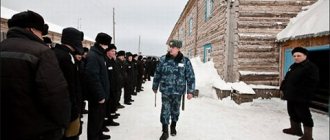Until reaching adulthood, a child cannot fully understand the consequences of his actions. Therefore, all responsible decisions for a minor are made by parents. If a child has committed a crime, then he will have to answer on his own. However, due to behavioral, moral and intellectual development, juvenile offenders cannot be assigned to cells with adult prisoners. Therefore, the Russian system of correctional institutions provides special educational institutions designed to house those criminals who are under 18 years of age.
Below we will talk about juvenile colonies . How do child criminals live in educational institutions and how effective are such prisons in terms of rehabilitating juvenile bandits?
Modes of serving sentences
The Penal Code of the Russian Federation provides for the following regimes for the detention of minors:
- ordinary;
- lightweight;
- preferential;
- strict
New arrivals are placed in normal detention conditions by default. This is followed by a certain probationary period lasting three months. If during this period the teenager does not violate the established rules, he is transferred to a light regime. On the contrary, if a juvenile prisoner is found to have repeated violations, he is sent to a punishment cell. Persons who often have conflicts with fellow inmates are placed under strict conditions.
When the prison term comes to an end, the teenager is transferred to a preferential regime of detention. The grounds for transferring a convicted person from one regime to another are specified in Article 132 of the Criminal Executive Code of the Russian Federation.
For convicts serving their sentences under normal conditions, the following restrictions are established:
- 8 short-term dates and 4 long-term dates annually;
- the maximum amount of monthly expenses is 10,800 rubles.
While under light conditions, prisoners are allowed to:
- 12 short and 4 long dates per year;
- 11,400 rubles per month for food and other needs.
The preferential regime implies the following:
- unlimited spending of money;
- unlimited number of short-term and up to 6 long-term dates per year.
Under strict conditions the following restrictions apply:
- no more than 9,600 rubles monthly;
- 4 long and 6 short dates per year.
The living conditions of prisoners largely depend on the regime of detention. There are the following options:
- Being in facilitated, preferential and ordinary conditions, convicts live in dormitories.
- Strict conditions involve living in locked, isolated cells.
Why can a minor be sent to prison?
The main population of children's colonies are people aged 16-18 years. However, when committing particularly serious crimes, a 14-year-old attacker may also end up behind bars.
You can become a defendant in a criminal case and go to prison if you commit the following crimes:
- robbery;
- robbery;
- murder;
- terrorism;
- possession and distribution of drugs;
- car theft, etc.
Judges try not to use imprisonment for minors. This preventive measure is used only in extreme cases. For example, the crime was committed in the presence of aggravating circumstances, and the actions of the minor posed a great danger to society.
In case of minor offenses, such as hooliganism, police officers conduct educational conversations with juvenile offenders. For crimes of minor and medium gravity, suspended sentences are usually assigned.
Features of life in educational colonies
Minor boys and girls are kept in separate correctional facilities. On the territory of the correctional institution there are special rules that prisoners must adhere to. Conditions in colonies for minors are more lenient compared to adult prisons.
Have a question for a lawyer? Ask now, call and get a free consultation from leading lawyers in your city. We will answer your questions quickly and try to help with your specific case.
Telephone in Moscow and the Moscow region: +7
Phone in St. Petersburg and Leningrad region: +7
Free hotline throughout Russia: 8 (800) 301-39-20
Let's consider the main features of the content:
- Children are brought to work. The number of working hours is determined depending on the age of the convicted person. Juvenile criminals sew and make furniture.
- Children are prohibited from working on weekends and at night.
- Minors are required to attend classes according to the standard school curriculum.
- 50% of the funds earned in the colony are transferred to the convicted person’s account.
- Rising in children's colonies occurs at 6:30 in the morning, and not at 6:00, as in adults. Before each significant lesson, the prisoners are lined up.
- While serving a sentence in places of deprivation of liberty, a minor has the right to receive correspondence education.
Thieves' songs
These days, prison romance has exploded thanks to the Internet. There are many sites and groups on social networks with thieves themes. Hundreds of thousands of young people are members of them. But to join the ranks of the movement, you don’t need to sign up anywhere—it’s enough to declare your belonging to this subculture to your surroundings. Moreover, leaving AUE is much more difficult than entering.
In many ways, AUE resembles a totalitarian sect. They also have a very negative attitude towards other views on life, actively attract new supporters, collect donations and do not allow them to start an ordinary life. Supporters of this subculture do not want to work. According to their concepts, one can only steal, rob, or, at worst, deceive. There is no need to study, get an education or just read books - everything will be explained by your senior comrades.
Children are being raised to be seasoned criminals. But why is their image so popular? TV series like “Brigade”, “Cops”, “Gangster Petersburg” are constantly shown on the television screen. Channel One launched the criminal song show “Three Chords,” which openly promotes a criminal lifestyle. Therefore, you should not be surprised if in a couple of years a whole army of people who do not want to obey the laws grows up.
Troubled teenagers used to have an alternative, but now they simply don’t. Alas, the state has been caring for the younger generation only in words for more than 25 years. The Pioneers and Komsomol were destroyed, but nothing new was created in their place. In the Soviet Union there were free sections, but now they are all closed. Children in many cities, villages and towns simply have nothing to do. So they form gangs, copying the behavior of the prisoners. There are no social elevators in the country, especially far from large cities. However, they have now stopped talking about them. Children of poor parents do not see any other future for themselves other than a prison cell, and they are preparing for it.
This problem has reached the highest level. In January 2016, Vladimir Putin accepted the resignation of the Governor of Transbaikalia, Konstantin Ilkovsky , who resigned precisely because of rampant child crime in the region.
Golden youth bathes in luxury. The appearance of thieves schoolchildren is a protest against the stratification of society. Source: Instagram.com
The end of the period of stay in the colony
If the convicted person turns 18 years old, but has not yet served the entire sentence, then his future fate may be as follows:
- An adult prisoner is left in a correctional colony. This option is used if the prisoner has a couple of months left to serve, and therefore transferring him to another prison camp is impractical. According to the general rules, a prisoner can be left in a children's colony for a maximum of a year, that is, until he reaches his 19th birthday.
- The convicted person is transferred to a correctional facility designed to house adult criminals.
The decision to transfer a minor is made by the head of the correctional institution together with the prosecutor. Transfer to a correctional colony is possible only by court order. In most cases, persistent violators of the prison regime and persons with a significant prison term end up in adult prison.
When a prisoner turns 19, he is automatically transferred to a correctional colony. There are no court hearings - just a resolution from the head of the colony is enough.
Generation of morons
At a meeting of the Council for the Development of Civil Society, its executive secretary, Yana Lantratova, told the president about the inculcation of criminal ideology and practices:
“A man is sitting in prison, he has people watching outside, they contact children in social institutions, establish their own rules. And teenagers are forced to donate to the common fund for the zone, and if a child cannot hand over money or steal and commit a crime, he goes into the category of the degraded, he has a separate desk, separate dishes, he can be bullied and raped... The worst thing, Vladimir Vladimirovich that when they leave these special schools, there will be a whole army of them. This is a national security issue."
The President ordered the creation of an interdepartmental working group to prevent the criminalization of teenagers. But for now, criminals continue to terrorize entire regions and dream that Russia will live according to their concepts, and for this they are raising their replacements. I don’t even want to imagine what will happen to our country if in a few years people raised on this subculture become adults. Experts believe that the reason for its emergence is the lack of a clear state ideology, the cult of profit, the lack of rights of the common man, and the process of widespread introduction of thieves’ romance into the everyday life of a teenager is man-made and purposeful. Some people really want a generation of morons to grow up in Russia, brought up on concepts destructive to the state.
This subculture can be combated by lowering the age of criminal responsibility, but the most important thing is to offer young people a clear alternative and give them the opportunity to realize themselves for the benefit of society.
It is believed that the dashing 90s with rampant crime have sunk into oblivion. If nothing is done, they will soon seem like just flowers to us.
Reward and punishment measures used in colonies
The conditions of his stay in a juvenile colony largely depend on the behavior of the convicted person. Guided by Articles 135 and 136 of the Penal Code of the Russian Federation, prison administration has the right to introduce incentives and punishments for prisoners.
For good behavior, convicts can count on the following rewards:
- mitigation of conditions of detention;
- the opportunity to leave the pre-trial detention center early;
- attending cultural and sporting events taking place outside the colony (in the presence of a correctional officer);
- the opportunity to leave the MLS accompanied by relatives.
If a teenager often conflicts with other inmates and the administration of the institution, then the following sanctions may be applied to him:
- confinement in an isolation ward;
- transfer to stricter conditions of detention;
- issuing a reprimand;
- fine (maximum amount 2 minimum wages);
- prohibitions on leisure activities.
Where are juvenile colonies located in the Russian Federation?
On the territory of modern Russia there are 24 institutions designed for the re-education of juvenile criminals. And only 2 of them are intended for criminal girls.
Educational colonies are located in the following regions of the Russian Federation:
- Moscow region - 2 colonies;
- Belgorod region - a colony for girls;
- Altai Territory - 2 colonies;
- Krasnoyarsk, Krasnodar and Primorsky Territories - one correctional institution each;
- one colony each in Samara, Rostov, Ryazan, Omsk, Nizhny Novgorod, Orenburg, Novosibirsk, Volgograd and Voronezh regions.
In total, there are about 1,700 prisoners in Russian juvenile correctional institutions. According to statistics, most teenagers take the path of correction, as a result of which they are transferred to easier conditions. Only a few are subject to strict regime.
The main goal of juvenile colonies is not to punish child criminals, but to educate them and suppress future crimes. Many teenagers who have committed serious crimes graduate from school at MLS, learn to work, and are released as full-fledged members of society.
How juvenile delinquents were re-educated under the Tsar
Documents from the judicial and prison departments of the era of the Tsar-Father indicate that in those distant times, teenagers were not very different from the kids of today who commit criminal acts, and also served prison terms in the colonies of the Russian Empire. It’s just that at that time there were few juvenile criminals compared to today, and serious crimes committed by teenagers were generally rare.
In the 70s In the 19th century, special shelters and colonies began to appear in Russia, which began to house minors who had committed crimes without malicious intent. But, as you know, in Rus' there has always been a shortage of something, including places in such government institutions, so most of the child convicts had to sit in a regular prison together with adult criminals. And only the lucky ones got a place on the “youngster”.
It should be said that in the colonies of that time there were no barbed wire or police guards. There was only a regular fence enclosing the area. Depending on the number of places, the number of re-educated people in such colonies ranged from approximately 35 to 150 people. The staff of educators and service personnel was ridiculous by today's standards: up to 8-14 people (and this is in the absence of guards!).
What criminal acts did teenagers commit under the Tsar-Father that led them to correctional colonies? The vast majority - 90% - involved theft, concealment, sale or appropriation of stolen goods. The remaining 10% included robberies and robbery, murder and attempted murder, arson, crimes “against morality” and “public order”, insult to parents, sacrilege, beggary and vagrancy (for comparison: at present, 25% of all convicted teenagers are in prison colonies for serious crimes: murder, robbery, robbery, rape).
Portrait of a special contingent
In addition to the children of peasants, townspeople and workers, who form the basis of any colony, there were also children from other classes: nobles, officials, clergy, merchants and honorary citizens. True, judging by the documents of the judicial and prison department, there were only a few of them. Two-thirds of the entire contingent of colonies and special shelters for minors were of the Orthodox faith, followed by Catholics and Jews. Representatives of other religions met very rarely.
Half of the convicted teenagers had two-parent families, 10% had only a mother, just over 5% lived with their father, 5% were orphans. There were approximately 35% of juvenile delinquents who were completely illiterate.
Once in the colony, not all the children “embarked on the path of correction.” Many teenagers continued to commit outrages there as well. The most common were “laziness and negligence”, bullying by elders over younger ones, escapes and unauthorized absences, fights, disobedience and refusal to work, “bad attitude towards comrades”, deception and lies, theft and assassination attempts. In addition, the “children” of the times of the Tsar-Father, while in the colony, committed “crimes against morality”, wasted government property, drank alcohol and smoked, were rude to educators and service personnel, played prohibited gambling, “violated reverence in churches and at prayer,” and it happened that they staged a riot—“disobedience en masse.”
Life in a colony
In Vladivostok there was no educational colony or special shelter for minors and juvenile delinquents. And the closest of them were in Chita and Irkutsk. And therefore, those who committed fines were sent there, which, however, happened extremely rarely, or, as a rule, they were left at the Vladivostok prison together with adult prisoners.
Let's look at the conditions in which the pupils of one of the small “agricultural and craft” colonies in central Russia lived, the purpose of which, like others like it, was “the correctional education of male minors placed in a colony by court sentences.”
The colony had 35 places. Children aged from 10 to 18 years old were heading here. The average length of their stay here was 3 years. The pupils were divided into two groups, or, as they said then, “families” according to age. As punishment, those who committed the fine were subject to a reprimand, deprivation of tea or rolls, hot food for one or several days, and imprisonment in a punishment cell. There was no corporal punishment as such in this institution, “they were practiced in a number of others,” but in exceptional cases, for example, for theft or escape they could be torn out with rods like Sidorov’s goat.
As entertainment in their free time, pets were allowed to participate in various group games, sing, and take walks in the surrounding forest. As an incentive, those working in craft workshops were paid 10% of the amount earned, and those involved in economic affairs in the colony were given a small cash bonus upon leaving it. Again, such material incentives were only in this and a few other similar institutions; in the rest there was no talk of any monetary payments. But if in other special institutions, along with “socially useful” work, literacy and crafts were taught all year round, then in this school classes were conducted only in winter, at other times of the year - work, work and more work.
The daily routine here was as follows. In summer wake up at 5 o'clock. 30 min. (in winter - at 6 o'clock). Then general prayer, assignment to work. At 8 o'clock. - breakfast, from 9 to 12 o'clock. - work, lunch, rest until 2 p.m., after which work again until 5 p.m., tea and “smoke break” until 6 p.m. And again work until 20 o'clock. Then dinner, the director summing up the results of the day, evening prayer, and lights out at 10 p.m.
The diet of young children and teenagers was almost the same in winter and summer: cereal soups, cabbage soup, porridge, potatoes, beef, tea and bread. On holidays, they could replace porridge with pie, cook jelly, or serve white bread for tea. On fasting days they treated themselves to fish (for some reason there was not a word about vegetables and fruits in any of the menus of the then shelters and colonies).
In each colony, pupils were dressed differently. In our case, these were canvas trousers, a shirt, an apron, and a belt; in winter, jackets made of army cloth with cotton wool, wadded trousers and dried boots. They slept on felt mattresses covered with canvas, a pillow stuffed with straw, and under a flannelette blanket. Washing in the bathhouse and changing bed linen once every two weeks. Once a week a doctor visited the colony.
They also imprisoned young girls
There were also correctional shelters for girls in Rus', the purpose of which was “the care and education of young girls, beggars, homeless people, as well as those convicted by the district court or justices of the peace.” We were sent to such establishments from the age of 5. Here the girls were taught literacy according to the curriculum of 3-year primary schools and colleges, the Law of God, and also instilled the skills of gardening and women's crafts. Games, walks, music and singing were allowed as entertainment in free time. Violators of discipline, depending on the severity of the offense, could simply be “admonished”, or could be locked in a punishment cell, in extreme cases, “with the permission of the guardianship of the shelter”, subjected to corporal punishment, i.e. ordinary caning.
True, there were also “gingerbreads”: students were given books based on the exam results, and Christmas and New Year trees with gifts were organized. Those who successfully completed the full course of study received certificates and cash benefits.
At the same time, it should be noted that there were few such correctional institutions - only about 50, as a rule, one in each province (in some regions, one for 2-3 provinces), and the number of places for “re-education” is extremely limited, so most convicts young children and teenagers had to sit on bunks in arrest houses, detention facilities and prisons for adults with all the ensuing consequences. Only a few of the “state houses” had separate cells for teenagers. About a third of convicted teenagers studied school literacy in prison, learned the wisdom of certain crafts, and were engaged in household work. The rest of their comrades did not want to study or work...
And at that time, such a punishment as imprisonment in a monastery was applied to minors. In order to bring the lost children to reason with work and prayer behind the strong monastery walls.
The terms of imprisonment depended on the severity of the crime committed and the presence of malicious intent. Hard labor and the death penalty were used as exceptional measures.
Execute only from 21 years of age!
In 1897, a new law on juvenile and juvenile delinquents was adopted, according to which the punishments for them were somewhat softened. So, for example, if previously prosecution could be applied to nine-year-olds, now no earlier than from the age of 10.
Minors from 10 to 17 years old, recognized by the court as having committed a criminal act “without understanding,” were henceforth “under responsible supervision at the discretion of the court or to their parents, or persons in whose care they are, or other trustworthy people who have expressed their consent. If the law prescribes a punishment of no less than imprisonment for the criminal act committed, then the said minors may be sent to correctional shelters or colonies for juvenile offenders, where these institutions are established.”
Those who, at the age of 14-17, committed crimes “with understanding”, i.e. intentionally, and very seriously, then according to the new law, instead of the death penalty or hard labor, they were put on prison bunks for a term of 8 to 12 years. And minors from 17 to 21 years old for such acts received 20 years of hard labor, whereas previously they were executed or sentenced to indefinite hard labor for this. But the main thing in the new law was that from now on, before reaching the age of 21, no one in the Russian Empire should be subjected to the death penalty.











